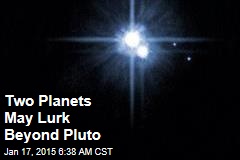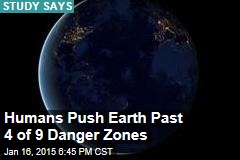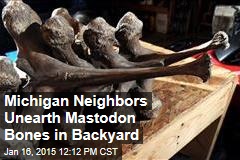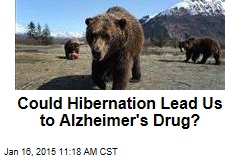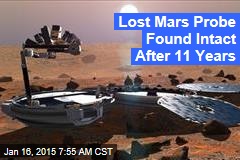| NASA, NOAA find 2014 warmest year in modern record Posted: 16 Jan 2015 12:39 PM PST The year 2014 ranks as Earth's warmest since 1880, according to two separate analyses by NASA and National Oceanic and Atmospheric Administration (NOAA) scientists. The 10 warmest years in the instrumental record, with the exception of 1998, have now occurred since 2000. This trend continues a long-term warming of the planet, according to an analysis of surface temperature measurements.  |
| Machines teach astronomers about stars Posted: 16 Jan 2015 11:56 AM PST Astronomers are enlisting the help of machines to sort through thousands of stars in our galaxy and learn their sizes, compositions and other basic traits. The research is part of the growing field of machine learning, in which computers learn from large data sets, finding patterns that humans might not otherwise see.  |
| NASA satellite set to get the dirt on Earth's soil moisture Posted: 16 Jan 2015 11:54 AM PST A new NASA satellite that will peer into the topmost layer of Earth's soils to measure the hidden waters that influence our weather and climate is in final preparations for a Jan. 29 dawn launch from California.  |
| Scientists pinpoint saturn with exquisite accuracy Posted: 08 Jan 2015 08:11 AM PST Scientists have paired NASA's Cassini spacecraft with the National Science Foundation's Very Long Baseline Array (VLBA) radio-telescope system to pinpoint the position of Saturn and its family of moons to within about 2 miles (4 kilometers). The measurement is some 50 times more precise than those provided by ground-based optical telescopes. The feat improves astronomers' knowledge of Saturn's orbit and benefits spacecraft navigation and basic physics research.  |
| NASA mountaintop sensor finds high methane over Los Angeles Posted: 16 Jan 2015 11:46 AM PST A NASA study using two years of observations from a novel mountaintop instrument finds that Los Angeles' annual emissions of methane, an important greenhouse gas, are 18 to 61 percent higher than widely used estimates. The study is the first to demonstrate the feasibility of long-term mapping of greenhouse gases across an urban area from an elevated -- but still earthbound -- site.  |
| Asteroid to fly by Earth safely on January 26 Posted: 16 Jan 2015 11:44 AM PST An asteroid, designated 2004 BL86, will safely pass about three times the distance of Earth to the moon on January 26. From its reflected brightness, astronomers estimate that the asteroid is about a third of a mile (0.5 kilometers) in size. The flyby of 2004 BL86 will be the closest by any known space rock this large until asteroid 1999 AN10 flies past Earth in 2027.  |
| NASA and ESA celebrate 10 years since Huygens probe landing on Saturn's moon Titan Posted: 16 Jan 2015 11:40 AM PST Ten years ago, an explorer from Earth parachuted into the haze of an alien moon toward an uncertain fate. After a gentle descent lasting more than two hours, it landed with a thud on a frigid floodplain, surrounded by icy cobblestones. With this feat, the Huygens probe accomplished humanity's first landing on a moon in the outer solar system. Huygens was safely on Titan, the largest moon of Saturn.  |
| NEOWISE: A yearlong look at the sky Posted: 16 Jan 2015 11:38 AM PST NASA's Near-Earth Object Wide-field Survey Explorer (NEOWISE) spacecraft discovered and characterized 40 near-Earth objects (NEOs) in the first year after the mission was re-started in December 2013. Eight of the discoveries have been classified as potentially hazardous asteroids (PHAs), based on their size and how close their orbits could come to Earth's orbit.  |
| New salmonella serotype discovered Posted: 16 Jan 2015 11:38 AM PST A new serotype of the salmonella bacteria has been discovered by Texan researchers. Because convention calls for a new serotype to be named after the city in which it is discovered, this one will be called Salmonella Lubbock. And while Lubbock is known for many things, like being the home of Buddy Holly, this new honor will provide new avenues for research into the bacteria's prevention, researchers suggest.  |
| Crystal-rich rock 'Mojave' is next Mars drill target Posted: 16 Jan 2015 11:35 AM PST A rock target where NASA's Curiosity Mars rover is using its sample-collection drill this week may have a salty story to tell. This target, called "Mojave," displays copious slender features, slightly smaller than grains of rice, that appear to be mineral crystals. A chance to learn their composition prompted the Curiosity science team to choose Mojave as the next rock-drilling target for the 29-month-old mission investigating Mars' Gale Crater. The features might be a salt mineral left behind when lakewater evaporated.  |
| New genetic clues found in fragile X syndrome Posted: 16 Jan 2015 10:47 AM PST New insight into fragile X syndrome -- the most common cause of inherited intellectual disability -- has been gained by researchers studying the case of a person without the disorder, but with two of its classic symptoms.  |
| Michigan autoworkers fare worse when it comes to the heart Posted: 16 Jan 2015 10:47 AM PST Michigan's autoworkers are at a higher risk of heart disease compared to the US population overall, a study has found for the first time. The research also showed that the prevalence of diabetes among this group was 15.3 percent; double the national average of 7.5 percent at the time of the study.  |
| Performance-based funding in community colleges hinders success of at risk students Posted: 16 Jan 2015 10:47 AM PST Performance-based funding (PBF) for Texas community colleges could disproportionately penalize colleges that predominately serve students from disadvantaged backgrounds, a new report suggests.  |
| BPA exposure affects heart health of males, females differently in mouse models Posted: 16 Jan 2015 10:47 AM PST Heart function and blood pressure in mice exposed to bisphenol A, BPA, from birth though young adulthood are affected differently in males and females, with females at greater risk of damage from stress, a study has found.  |
| Unlocking the mysteries of the real Paddington bear Posted: 16 Jan 2015 10:46 AM PST WCS and partners in Bolivia, Colombia, and Peru have published four significant contributions towards the conservation of the real Paddington Bear -- the Andean bear (Tremarctos ornatus).  |
| Peat fire emissions may shed light on climate change Posted: 16 Jan 2015 10:45 AM PST Researchers are beginning a study of the climatic effects of peat fire emissions. "This project is going to provide the much-needed information on peat smoke aerosol properties for integration in satellite retrieval algorithms and climate models," the lead researcher says. "Based on my initial findings, I hypothesize the peat smoke is made up of brown carbon and not black carbon. Brown carbon is a class of organic carbon aerosol which, unlike black carbon, strongly absorbs incoming solar radiation in the shorter wavelengths, or near ultraviolet."  |
| First pharmacological guideline for obesity treatment provides clinical roadmap for anti-obesity drug treatment Posted: 16 Jan 2015 10:45 AM PST The first-ever clinical practice guideline for the drug treatment of obesity offers a new tool for health practitioners looking to the latest pharmacotherapy strategies as a means of treating patients with obesity. The Obesity Society says the guideline supplements the TOS/AHA/ACC Obesity Treatment Guidelines to fill a gap in treatment.  |
| Picture this: Biosecurity seen from the inside Posted: 16 Jan 2015 08:54 AM PST Scientists get an insider's view of plants under attack. They've developed a new biosensor that allows them to see, in real time, what happens when a plant's defence system swings into action.  |
| New device for measuring how birds take flight Posted: 16 Jan 2015 08:03 AM PST A new device promises to answer long-held questions about the forces birds generate while flying, and could lead to the development of innovative, efficient unmanned aerial vehicles.  |
| Solving an organic semiconductor mystery Posted: 16 Jan 2015 08:03 AM PST The mysterious source of performance issues in organic semiconductors have been uncovered by scientists -- nanocrystallites cluttering domain interfaces.  |
| HiRISE camera spots long-lost space probe on Mars Posted: 16 Jan 2015 07:44 AM PST The Beagle 2 Mars Lander, thought lost on Mars since 2003, has been found partially deployed on the surface of the planet, ending the mystery of what happened to the mission more than a decade ago.  |
| Software that knows the risks Posted: 16 Jan 2015 07:44 AM PST New planning algorithms developed by researchers can evaluate a probability of success, and suggest low-risk alternatives. For example, if you told your computer that you want to drive from your house in Boston to a hotel in upstate New York, that you want to stop for lunch at an Applebee's at about 12:30, and that you don't want the trip to take more than four hours. Just imagine if software could then tell you that you have only a 66 percent chance of meeting those criteria -- but that if you can wait until 1:00 for lunch, or if you're willing to eat at TGI Friday's instead, it can get that probability up to 99 percent.  |
| Antiquity of dairying on Emerald Isle revealed Posted: 16 Jan 2015 07:44 AM PST The antiquity of dairy farming in Ireland has been outlined by researchers in a new report. The research shows that dairying on the island goes back approximately 6,000 years, revealed through traces of ancient dairy fats found in pots dating to around 4,000 to 2,500 BC.  |
| Breakthrough lights up metamaterials Posted: 16 Jan 2015 06:30 AM PST Researchers have successfully demonstrated how to both enhance light emission and capture light from metamaterials embedded with light emitting nanocrystals. The breakthrough could lead to a range of applications including ultrafast LEDs, nanoscale lasers and efficient single photon sources.  |
| Satellite telemetry tracks bearded vultures Posted: 16 Jan 2015 06:30 AM PST The Pyrenees are home to continental Europe's only wild population of bearded vultures, a species classified as endangered in Spain. A study compiled by Spanish researchers reveals -- in a level of detail until now unseen -- the size of the home range of this bird species using satellite tracking technologies.  |
| Three nearly Earth-size planets found orbiting nearby star: One in 'Goldilocks' zone Posted: 16 Jan 2015 06:30 AM PST NASA's Kepler Space Telescope has discovered a star with three planets only slightly larger than Earth. The outermost planet orbits in the 'Goldilocks' zone -- where surface temperatures could be moderate enough for liquid water and perhaps life to exist. The star ranks among the top 10 nearest stars known to have transiting planets. The star's close enough for astronomers to study the planets' atmospheres to determine if they could possibly be conducive to life.  |
| Is it possible to reset our biological clocks? Posted: 16 Jan 2015 06:30 AM PST Imagine being able to easily get over all of the discomfort and problems of jet lag or night-shift work. Science is not quite there, but recent has opened new therapeutic avenues for improving the synchronization of the body's different biological clocks.  |
| 2,500-year-old Pythagoras theorem helps to show when a patient has turned a corner Posted: 16 Jan 2015 06:24 AM PST A medical researcher has found the 2,500 year-old Pythagoras theorem could be the most effective way to identify the point at which a patient's health begins to improve.  |
| Bicyclists willing to ride up to 3 miles to catch bus, train Posted: 16 Jan 2015 06:23 AM PST Only about 2 percent of commuters in three metro areas - Atlanta, the Twin Cities and Los Angeles - reported pedaling their bicycles to the transit station, suggesting the need for better infrastructure, a researcher reports.  |
| Bone stem cells shown to regenerate bones, cartilage in adult mice Posted: 16 Jan 2015 06:00 AM PST A stem cell capable of regenerating both bone and cartilage has been identified in bone marrow of mice. The cells, called osteochondroreticular (OCR) stem cells, were discovered by tracking a protein expressed by the cells. Using this marker, the researchers found that OCR cells self-renew and generate key bone and cartilage cells, including osteoblasts and chondrocytes. The discovery has implications for bone repair, the scientists say.  |
| Closing your eyes boosts memory recall, new study finds Posted: 16 Jan 2015 05:56 AM PST Further evidence has been found to suggest that eyewitnesses to crimes remember more accurate details when they close their eyes. The team also discovered that building a rapport with witnesses also helped them to remember more.  |
| Wild pollinators at risk from diseased commercial species of bee Posted: 16 Jan 2015 05:56 AM PST Viruses carried by commercial bees can jump to wild pollinator populations with potentially devastating effects. The researchers are calling for new measures to be introduced that will prevent the introduction of diseased pollinators into natural environments.  |
| Tool helps measure patients' readiness to make decisions about starting dialysis Posted: 16 Jan 2015 05:56 AM PST A new algorithm is a useful tool for measuring chronic kidney disease patients' readiness for making decisions about initiating dialysis. Patients who have knowledge about their options and have fewer lifestyle barriers to home dialysis are more likely to be ready to make decisions. Doctors who explain all of the treatment options that are available can increase patients' readiness for decision-making, say authors of a new study.  |
| New trick found for how cells stay organized Posted: 16 Jan 2015 05:56 AM PST Organization is key to an efficient workplace, and cells are no exception to this rule. New evidence suggests that, in addition to membranes, cells have another way to keep their contents and activities separate: with ribbons of spinning proteins.  |
| Rare mutations do not explain 'missing heritability' in asthma Posted: 16 Jan 2015 05:55 AM PST Rare genetic mutations have been thought to explain missing heritability, but it appears they are unlikely to play a major role. Analyzing the coding regions of genomes of more than 11,000 individuals, scientists identified mutations in just three genes that were associated with asthma risk. Each was associated with risk in specific ethnicities, suggesting gaps in the current understanding of asthma genetics.  |
| Finding farmland: New maps offer a clearer view of global agriculture Posted: 16 Jan 2015 05:55 AM PST A new global cropland map combines multiple satellite data sources, reconciled using crowdsourced accuracy checks, to provide an improved record of total cropland extent as well as field size around the world.  |
| Heart arrhythmias detected in deep-diving marine mammals Posted: 16 Jan 2015 05:55 AM PST A new study of dolphins and seals shows that despite their remarkable adaptations to aquatic life, exercising while holding their breath remains a physiological challenge for marine mammals. The study found a surprisingly high frequency of heart arrhythmias in bottlenose dolphins and Weddell seals during the deepest dives.  |
| Investigations and complaints procedures have a serious impact on doctors' health, risk harming patients, study suggests Posted: 16 Jan 2015 05:53 AM PST Doctors who are the subject of complaints procedures or investigation by the General Medical Council experience high rates of serious depression and anxiety as well as suicidal thoughts, according to a new study based in England.  |
| Volcanic eruption on Cape Verde Island Posted: 16 Jan 2015 05:53 AM PST A new volcanic eruption commenced on Fogo, one of the Cape Verde Islands, on November 23rd, 2014. This eruption continues to date, and is considered to be the largest eruption by volume, and in terms of damage, on the archipelago for over 60 years. Most damage was caused by lava flows advancing into populated regions, so that numerous buildings, homes and roads were destroyed. In total, three villages have been abandoned and thousands of residents have had to be evacuated.  |
| New 'triggered-release' mechanism could improve drug delivery Posted: 16 Jan 2015 05:49 AM PST More efficient medical treatments could be developed thanks to a new method for triggering the rearrangement of chemical particles, scientists say. The new method uses two 'parent' nanoparticles that are designed to interact only when in proximity to each other and trigger the release of drug molecules contained within both The release of the drug molecules from the 'parent' nanoparticles could subsequently form a third 'daughter' particle, which comprises molecules from both 'parent' nanoparticles, researchers explain.  |
| Nanoparticles for clean drinking water Posted: 16 Jan 2015 05:49 AM PST One way of removing harmful nitrate from drinking water is to catalyse its conversion to nitrogen. This process suffers from the drawback that it often produces ammonia. By using palladium nanoparticles as a catalyst, and by carefully controlling their size, this drawback can be partially eliminated, researchers have discovered.  |
| Sensors could give machines more accurate sense of smell than that of humans Posted: 16 Jan 2015 05:49 AM PST Scientists have come up with a way of creating sensors which could allow machines to smell more accurately humans. Every odour has its own specific pattern which our noses are able to identify. Using a combination of proteins coupled to transistors, for the first time machines are able to differentiate smells that are mirror images of each other, so called chiral molecules, something that has not been possible before. The human nose can distinguish between some of these molecules and the different forms of the same molecule of carvone, for example, can smell either like spearmint or caraway. Previous machines would not have been able to distinguish between the two.  |
| Galactic 'hailstorm' in the early Universe Posted: 16 Jan 2015 05:49 AM PST Astronomers have been able to peer back to the young Universe to determine how quasars -- powered by supermassive black holes with the mass of a billion suns -- form and shape the evolution of galaxies. Two teams of astronomers have looked back nearly 13 billion years, when the Universe was less than 10 percent its present age, to determine how quasars -- extremely luminous objects powered by supermassive black holes with the mass of a billion suns -- regulate the formation of stars and the build-up of the most massive galaxies.  |
| Perovskites provide big boost to silicon solar cells Posted: 15 Jan 2015 01:35 PM PST Stacking perovskites onto a conventional silicon solar cell dramatically improves the overall efficiency of the cell, according to a new study.  |




